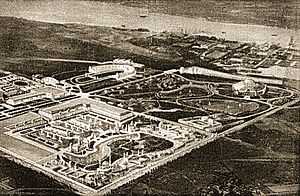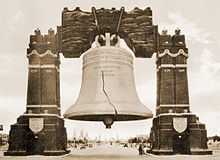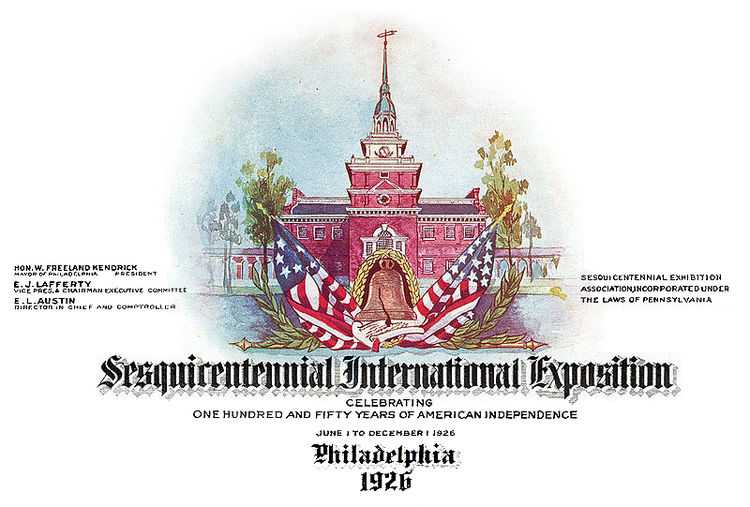Sesquicentennial Exposition

The Sesqui-Centennial International Exposition of 1926 was a world's fair in Philadelphia, Pennsylvania, to celebrate the 150th anniversary of the signing of the United States Declaration of Independence, and the 50th anniversary of the 1876 Centennial Exposition.
History
The honor of hosting this celebration was awarded to Philadelphia in 1921. Initial grand plans were scaled down tremendously by the time the fair opened. The original director of the exposition, Colonel David C. Collier, resigned in protest over these budget cuts.[1] His replacement, Captain Asher C. Baker, retired due to illness days before the festival opened, leaving things in the hands of E. L. Austin.[2] Baker died less than two weeks later.[3]

The fair opened on May 31, 1926, and ran through November on grounds bounded by 10th Street, Packer Avenue, 23rd Street, and the U.S. Navy Yard (Terminal Avenue) in South Philadelphia. Originally known as League Island Park, these grounds are now occupied by FDR Park, Marconi Plaza, Packer Park Residential Neighborhood, the three stadiums of Philadelphia's massive South Philadelphia Sports Complex (Wells Fargo Center, Lincoln Financial Field, and Citizens Bank Park), and the Philadelphia Eagles training complex which now occupy that portion of the grounds which from 1933 to 1993 were the site of Philadelphia Naval Hospital (demolished 2001).

The senior draftsman for the design of the exposition buildings was a young Louis Kahn, later a world-renowned architect, then working under City Architect John Molitor.[4] Sculptor Charles Tefft as chosen as the director of sculpture for the fair while noted Philadelphia sculptor and artist Albert Laessle created the fair's Medals of Award.[5]
The fair drew a much smaller crowd than anticipated (about 10 million people). It ended up unable to cover its debts and was placed into receivership in 1927, at which point its assets were sold at auction.[6]
Highlights

Organizers constructed an 80-foot replica of the Exposition's symbol, the Liberty Bell, covered in 26,000 light bulbs, at the gateway to the festival. Sesqui-Centennial Stadium (later known as Philadelphia Municipal Stadium, and after 1964, John F. Kennedy Stadium) was built in conjunction with the fair. Also on display at the exposition was the Curtis Organ, still one of the largest pipe organs in the world. In 1926 the first bridge (later renamed Benjamin Franklin Bridge) spanning the Delaware River between center city Philadelphia and Camden, New Jersey, was built in anticipation of the attending crowds.
Key speakers at the opening ceremonies were Secretary of State Frank B. Kellogg, Secretary of Commerce and future President Herbert Hoover, and Philadelphia Mayor W. Freeland Kendrick.[7] At the center of the exposition along the main thoroughfare on a segment of south Broad Street known as the Southern Boulevard Parkway was the Forum of Founders consisting of the Court of Honor, the Liberal Arts and Agriculture Buildings, a group of sculptures and the Stairway of Nations facing on the opposing side the spectacular Tower of Light.
The Exposition also included an amusement area, located within League Island Park. The area was designated as “Treasure Island.” It occupied over five acres and was referred to as a children’s paradise. A variety of amusements and entertainment were available. Included were a replica of the Canadian Rockies, a miniature railroad, mountain slide, Robinson Crusoe’s Beach, a pirate’s lair, boat rides and Noah’s Ark complete with animals.
Legacy
Benito Mussolini commemorated the Sesquicentennial by donating an ornate fountain to Philadelphia. Installed in Fairmount Park, it was neglected for many years before being restored in 2013.[8] A Commemorative stamp, showing the Liberty Bell (Scott catalogue number 627) was printed, and two Early United States commemorative coins were minted. These were a silver half dollar and a gold Quarter eagle. The fifty cent coin shows the heads of George Washington and Calvin Coolidge on the obverse, and the Liberty Bell on the reverse. The $2 1/2 coin has on the obverse Liberty holding a torch and the Declaration of Independence while standing on a globe; the reverse depicts Independence Hall. The stamp was issued in large numbers and is very inexpensive. The coins sold only moderately well, although both remain more common than many commemorative issues of this period.


See also
References
- ↑ "Collier Quits Directorship of Exposition". Los Angeles Times. 1925-10-30. p. 2.
- ↑ "Exposition Head Retires". New York Times. 1926-05-26. p. 27.
- ↑ "Capt. Baker dead; head of Exposition". New York Times. 1926-06-06. p. 28.
- ↑ Kahn, Louis Isadore (1901-1974) - Philadelphia Architects and Buildings
- ↑ Proske, Beatrice Gilman, Brookgreen Gardens Sculpture, Brookgreen Gardens, SC, 1968 p. 150
- ↑ City of Philadelphia Information Locator Service entry
- ↑ "Sesquicentennial opens as sun shines; 100,000 pass gates". New York Times. 1926-06-01. p. 1.
- ↑ Italian Fountain restored, getting ready to splash again this summer
External links
| Wikimedia Commons has media related to Sesquicentennial Exposition. |
- http://www.libertybellmuseum.com/WorldsFair/1926sesqui.htm[]
- Collection of Photographs from Sesquicentennial Exposition, PhillyHistory.org.
- Collection of artwork Postcards, Brochures, Photographs, related items from Sesquicentennial Exposition
| ||||||
Coordinates: 39°54′31″N 75°10′24″W / 39.9087158°N 75.1732635°W